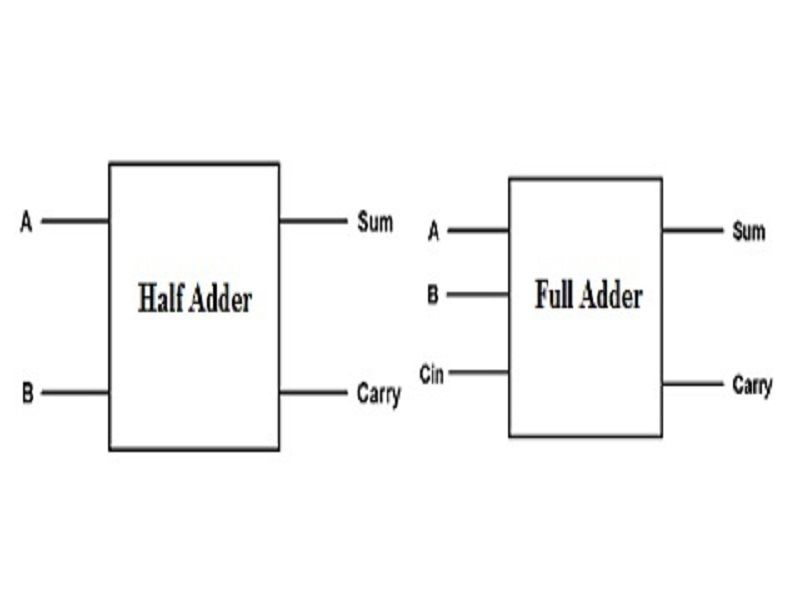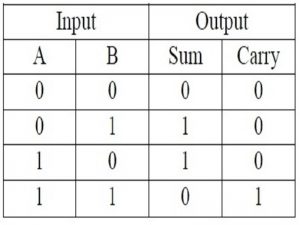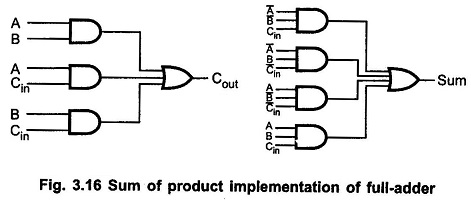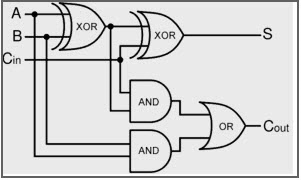What Is the Difference Between a Half Adder and a Full Adder?

Both Half adder and Full adder are combinational logic circuits, and they differ in terms of input processing. Any combinational circuit lacks memory components and consists only of logic gates. There is a significant distinction between half adder and full adder. Half adder only adds current inputs as 1-bit values and ignores prior inputs. Full Adder, on the other hand, can readily handle both the current inputs and the output from earlier adds.
These circuits have several features, such as the fact that the output of this circuit is mostly determined by the levels present at the input terminals at any given time. There is no memory in this circuit. The previous state of the input has no effect on the current state of this circuit. A combinational circuit has a n number of inputs and a m number of outputs. Combinational circuits include half and full adders, subtractors, encoders, decoders, multiplexers, and demultiplexers. This page provides an overview of half adders and full adders, as well as how they operate with truth tables.
What exactly is an Adder?
An adder is a digital logic circuit in electronics that is widely used for number addition. Adders are used in many computers and other types of processors to calculate addresses and associated actions, as well as table indices in the ALU and other portions of the processor. These may be created for a variety of number formats, such as excess-3 or binary coded decimal. Adders are divided into two types: half adders and full adders.
What exactly is a Half Adder?
A combinational logic circuit is what it is. It is possible to create it by connecting one AND gate and one EX-OR gate. A half-adder circuit is made up of two input terminals, A and B. Both of these add two input digits (one-bit values) and provide the result as a carry and a total. As a result, there are two output terminals.
The EX-OR gate produces the sum of both one-bit values as its output. The output of the AND gate is referred to as the carry. However, you cannot carry the carry obtained in one addition into another. It is due to the lack of a logic gate to handle it. As a result, it is known as the Half Adder
Let us first take a look at the addition of single bits.
0 + 0 = 0
0 + 1 = 1
1 + 0 = 1
1 + 1 = 10
Half Adder Logical Expression
Sum (S) = A ⊕ B
Carry (C) = A . B

These are the fewest single bit combinations that can exist. However, the outcome of 1 + 1 Equals 10 An EX-OR gate can be used to overcome this problem. The results of the sum may be rewritten as a 2-bit output.
It is now evident that a 1-bit adder can be readily created using an XOR Gate for the output ‘SUM’ and an AND Gate for the ‘Carry’.
For example, if we need to add two 8-bit bytes together, we can do it with a full-adder logic circuit. When adding one binary digit amounts, the half-adder comes in handy.
Limitations of the Half Adder
The fundamental reason these binary adders are referred to as Half Adders is that there is no range to include the carry bit by utilising an earlier bit. As a result, this is a major restriction of HAs when employed as a binary adder, especially in real-time circumstances involving the addition of many bits. As a result, this constraint can be addressed by utilising Full Adder
Full Adder
A Full Adder is a Combinational Logic Circuit that performs binary addition on integers with two digits. When compared to half adders, full adders are more sophisticated and difficult to install.

Full Adder Logical Expression
CARRY-OUT = AB + BCin + ACin
SUM = (A ⊕ B) ⊕ Cin
The key difference between this and a half adder is that a full adder is a digital circuit used to calculate the sum of three binary bits. Two of the three bits, A, the augend bit, and B, the addend bit, are the same as previously. The third bit is a carry bit from the previous stage and is known as Carry-in, which is commonly denoted as CIN. It computes the sum of three bits combined with the carry. COUT represents the output carry, which is known as Carry-out.

A complete adder consists of two AND gates, two EX-OR gates, and one OR gate. Three binary digits are added using the complete adder. One of the three is the carry obtained from the previous addition as C-IN, while the other two are inputs A and B. It denotes the input carry as C-OUT and the standard output as S. (or SUM).
The Full Ladder, like the Half Adder, is a combinational form of logic circuit, which means it lacks a store element. However, it contains more logic gates. As a result, it adds the preceding carry to produce the full output. As a result, it is known as the Full Adder.
| Input | Output | |||
| A | B | C | SUM | CARRY OUT |
| 0 | 0 | 0 | 0 | 0 |
| 1 | 1 | 1 | 1 | 1 |
| 0 | 1 | 1 | 0 | 1 |
| 1 | 0 | 1 | 0 | 1 |
| 0 | 0 | 1 | 1 | 0 |
| 0 | 1 | 0 | 1 | 0 |
| 1 | 0 | 0 | 1 | 0 |
| 1 | 1 | 0 | 0 | 1 |
What is the difference between a half adder and full adder?
The following table compares the half adder and full adder tables.
Half Adder
- The Half Adder (HA) is a combinational logic circuit used to add two one-bit figures.
- In HA, once the carry from the previous addition is created, it cannot be added to the following step.
- The carry received from the previous addition is not added to the following one by the Half Adder.
- A Half Adder is made up of only one AND gate and one EX-OR gate.
- A Half Adder has two inputs: A and B.
- The Half Adder is useful for digital measurement equipment, computers, calculators, and many other applications.
- Half Adders are combinational logic circuits that add two 1-bit binary digits. It computes the carry and sum of both inputs.
Full Adder
- The Full Adder (FA) is a combinational circuit used to add three one-bit figures.
- Once the carry from the previous addition is created in FA, it may be added to the following step.
- The Full Adder is used in a variety of digital processors, the addition of multiple bits, and many more applications.
- In a Full Adder, there are three inputs: A. B. C-in.
- A Full Adder is made up of one OR gate and two EX-OR gates.
- FA is utilised in digital processors, multiple bit addition, and other applications.
- The Full Adder is another sort of combinational logic that performs addition by adding three of the 1-bit binary digits. It computes the total of all three inputs as well as the carry value.
- The Full Adder is another sort of combinational logic that performs addition by adding three of the 1-bit binary digits. It computes the total of all three inputs as well as the carry value.